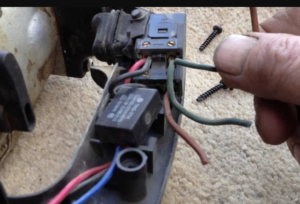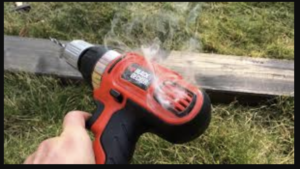What are some warning signs there could be something wrong with my power tools?
Just like our cars and trucks, boats, and ATV’s, power tools take a beating, perform and work hard when we demand them to do so. Over time, that brings on wear and tear, and just like all mechanical things, they can break down over time. Even our best tools can succumb to breaking down. It happens more often than we think. If you have ever heard your transmission grinding, or your belts on a sander screech and squeal, you knew immediately to shut the equipment down, and call your mechanic. Because something just didn’t seem right at the time. That is the same way we should treat our power tools. I do agree, some of our power tools do come with warranty’s, however, getting a manufacturer to do a warranty claim is a pain staking process all on its own. If we can see early warning signs, and know exactly what we need to do, then we may be able to save our selves headaches and money at the same time. WARNING: Always make sure your power tool is disconnected, has the battery or power source removed before you try diagnosing or repairing any issues you find yourself in the middle of.
PLEASE NOTE: This is from personal experience only, ToolCrunch.net is not liable for any injury to anyone or their property. This is simple a review article, not a set of instructions. All power tools are different but some are the same in some way.
My Power Tool Wont Start, Run, or Even Turn On
If adequate power is not getting from the power source, to the electrical motor, this can happen. The tool will be useless without the power and torque of our power tools.

What tools will I need to diagnose my power tool?
You need to keep a few tools around, to quickly get in, diagnose, and try to attempt to repair your power tool device. I would try and keep a multi-meter around, you can pick a multi-meter up on Amazon for a cheap price. You also need to keep a set of smaller in size “Allen” style or HEX style key tools, screwdrivers, flat head, and Phillips head style. Electrical tape is another big player in these repairs. I also keep a can of air duster, or an air compressor near by.
If you can follow the main positive wire from the plug, or battery, to the electrical motor itself, you can use your multi meter to see if there is any current going to the motor. Also try and see if any wires have come loose, if any solder or connections are wobbly, or have fallen apart. A simple solder repair, or jump connector on a new wire, could save you hundreds of dollars in replacing good tools you had in the first place. You can also check for dirt, dust, grease or grime. Simply open up the plastic part of the power tool it self, blow a thin line of compressed air to remove any dirt or debris from any connections, or the electric motor. If your power tool used a brush style electric motor, follow the brush channels, and see if the ends are worn down or completely missing. Brush guides can be ordered online. You may also check the power cord, or battery. Sometimes a worn out power cable can become broken or damaged in different parts internally of the power cord, if you find yourself needing to replace the power tool motor, you need to purchase a good quality, well made power cable to keep constant protection from shock or damage to your power tool. A bad battery can be easily replaced.
Weak Power In My Power Tool Motor
When you are in the process of working on your car, and your drill has a week drive to it, and you could get the job faster with a hand tool, don’t immediately throw it away. Depending on the type of power tool you have, most have brush motors. Over time, the heat, wear and tear on them wear down the carbon brushes. Its a typical issue, and they have to be replaced ever so many years. If you get your power tool open and apart, and the carbon brushes seem to be fine, then try a couple more tips that we have for you.
Look for any burn marks, or signs of intense heat. Loose connections, or buildup around connections can cause the current of power not to be delivered from the power source (battery or outlet) to your power tools electric motor, brushless or brush style. You can take a soft bristle tooth brush, mix a small amount of water and baking soda, and gently brush these connections to remove any buildup or residue. Also check the wires inside and out for any breaks or deterioration.
If all options above have been checked, you more than likely need to replace the electric motor inside your power tool. From the research and experience I have, it cost’s a fraction of the cost of a replacement power tool to do this. However, depending on the age and brand of your power tool, sourcing that electric motor may be to expensive. At that point is only when I would recommend to you to replace the entire tool it self. Always remember that if you have space, save any recyclable power tools. I keep mine for parts.
Burning or Smoke Smell
Power tools that turn on, but don’t function or provide any power, you need to check a few of these tips below to see if this fits what you are smelling.
If you have a power tool that is belt driven, thats the very first place you should check. Belts were phased out, due to the constant quick wear and tear, then breakdown of them. However, some power tools such as belt sanders or planers still use belts to drive power from the electrical motor to the moving tool part(s) and need to be periodically checked.
If your power tool is not belt driven, you need to check for any wires that have started to get hot and over heat. Poor connections can cause insulated wiring to heat up, slowly smoldering the insulation plastic that surrounds that wire.
If you have checked, and verified all wiring is fine, and all connections are clean, the next step is any circuit boards, capacitors, or internal fuses on the power tool. If its excessively hot or damaged. This rarely occurs, and has never once happened during the time I have ever owned power tools.
The final check is the motor it self. You need to examine your power tool motor, see if you have any kind of wear on your brush motor. The brush motor contains carbon brushes, that heat up and wear down over time. That would be the first thing to check, if your motor is over heated, or working to hard, it will slowly start to rise in temperature, that will take away any kind of power delivery, as well as efficiency on any battery (if the tools are battery operated). Allow the motor to cool, and then examine it for damage to any coils, copper wires, carbon brushes, etc. Also check for excessive dust build up. When dust is heated up, it will literally burn, which will mimic the electrical fire smell its famous for.
Loud Screeching Noises
We all know that power tools produce high decibel noises, but its a noise well are well used to. Its only when you hear a loud squeal or screech noise, is when you need to be concerned. Allow your power tool to “cool ” down, then diagnose the problem. The first place I always check is the head chuck, or power delivery system. Thats the mechanism that is located between the motor and head of the tool. Check for dirt, grease or grime. Clean it out completely, and before reassembly, use proper general purpose oil to give it a fresh lubrication. This will help reduce friction, and prevent those loud noises entirely. You also should check the gears inside your power tool, again for any kind of foreign objects, debris, or dirt. Properly clean, and replace any gears that are damaged. I have to source most of my gears from tools I have recycled from past use. You will not find these gears anywhere else. Periodically you need to lubricate these vital parts of your power tools, so you keep them for a long time.
Conclusion
Just like your car or truck, by doing simple proper maintenance of your power tools can save you hundreds of dollars down the road. One of the most important pieces of information you can get with any power tool, is the manufacturers users guide. It will have information pertaining specifically to your power tool. How it works, what types of parts, oils, and things to use on it, and where to get replacement parts if you ever needed them. It would be a wise decision to get into a routine, of checking and maintaining your expensive power tools. This will help reduce any future problems down the road.

